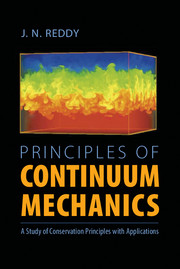Book contents
- Frontmatter
- Contents
- Preface
- 1 Introduction
- 2 Vectors and Tensors
- 3 Kinematics of a Continuum
- 4 Stress Vector and Stress Tensor
- 5 Conservation of Mass, Momentum, and Energy
- 6 Constitutive Equations
- 7 Applications in Heat Transfer, Fluid Mechanics, and Solid Mechanics
- Answers to Selected Problems
- References and Additional Readings
- Subject Index
5 - Conservation of Mass, Momentum, and Energy
- Frontmatter
- Contents
- Preface
- 1 Introduction
- 2 Vectors and Tensors
- 3 Kinematics of a Continuum
- 4 Stress Vector and Stress Tensor
- 5 Conservation of Mass, Momentum, and Energy
- 6 Constitutive Equations
- 7 Applications in Heat Transfer, Fluid Mechanics, and Solid Mechanics
- Answers to Selected Problems
- References and Additional Readings
- Subject Index
Summary
It is the mark of an educated mind to be able to entertain a thought without accepting it.
AristotleIntroduction
Virtually every phenomenon in nature, whether mechanical, biological, chemical, geological, or geophysical, can be described in terms of mathematical relations among various quantities of interest. Such relationships are called mathematical models and are based on fundamental scientific laws of physics that are extracted from centuries of research on the behavior of mechanical systems subjected to the action of external stimuli. What is most exciting is that the laws of physics also govern biological systems because of mass and energy transports. However, biological systems may require additional laws, yet to be discovered, from biology and chemistry to complete their description.
This chapter is devoted to the study of the fundamental laws of physics as applied to mechanical systems. The laws of physics are expressed in analytical form with the aid of the concepts and quantities introduced in previous chapters. The laws or principles of physics that we study here are the principle of conservation of mass, the principle of conservation of linear momentum, the principle of conservation of angular momentum, and the principle of conservation of energy. These laws allow us to write mathematical relationships – algebraic, differential, or integral – of physical quantities such as displacements, velocities, temperatures, stresses, and strains in mechanical systems.
- Type
- Chapter
- Information
- Principles of Continuum MechanicsA Study of Conservation Principles with Applications, pp. 111 - 148Publisher: Cambridge University PressPrint publication year: 2010



